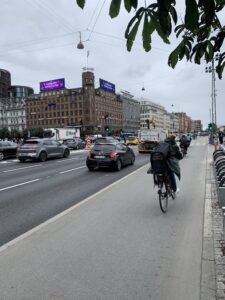
Bike lane widths vary in Copenhagen – this one is very wide. But the over-riding goal is to ensure the lane is protected, even if it needs to be narrower to make that happen.



This protected bike lane width is more typical at 7 to 8′ wide.

This is an unusual material – most are asphalt. It is a bit dizzying to have the bike lane and sidewalk same materials. The other less common feature here is that the bike lane is same elevation as sidewalk, but raised slightly above street grade.

This one is different in that all of the above use just the curb to separate from the road. This one has a cobbled parkstrip that converts to a right turn lane. This bike lane is also just 6′ wide to accommodate the turn lane.
The basis for the entire Copenhagen transportation network is 1) to connect people to other people and places, and 2) to efficiently accommodating growth. Copenhagen works really hard to make sure they achieve their transportation goals.
The one-way protected bike lane is a key ingredient to their recipe for success.
Every single main street and most of the minor streets have a protected bike lane. You feel safe. Protected. Cared for. It is a really nice feeling. Also riding along with hundreds of Copenhageners that are all riding politely and with supreme confidence is an amazing feeling. They just chatter away to their companions, or on their Bluetooth devices. Or ride quietly enjoying their day. There is no worries about traffic safety – traffic safety is completely and utterly built right into the design. Safer by Design. More Usable by Design.
The protected bike lanes here are raised up just an inch or so above the street level, and are just an inch or so below sidewalk level.
As the protected bike lane approaches an intersection, it dips back down to street level to accommodate turning movements.
It picks back up when you get through the intersection. It’s like that old AT&T ad campaign – fewest dropped calls. In Copenhagen, you are never dropped from a protected bike lane. Rest assured that it will be there when you turn the corner or cross the intersection. The beauty of this system is that you just ride, and grock your way around the town. Every route is a viable route. Just point yourself towards the destination and you know that whatever combination of straight, lefts and rights you make you’ll arrive perfectly fine.
Next up…the Copenhagen Left and Right Turn Treatments, Who Rides in Copenhagen, and How does their hierarchy work…Come visit again for more details!

2 Comments
Marc Schlossberg · June 23, 2022 at 3:25 pm
Great to read along with your experiences!
Robin · June 24, 2022 at 8:11 pm
Really excited to be here. It is nice to have met several staff at Jan Gehl Architects today. Interesting to hear that they have the same conversations with people about how to create space, how to efficiently grow and successfully meet transportation needs as they grow, and how to safely connect people and places.